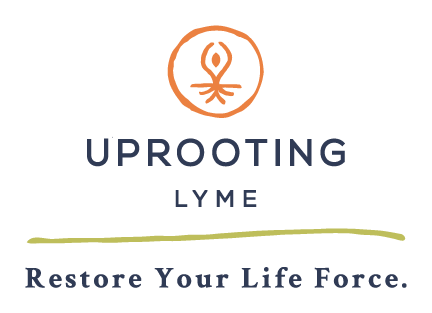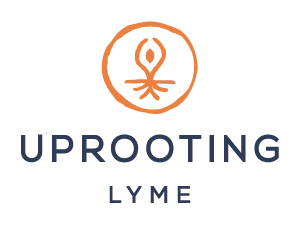
Lyme Disease and Menstrual Cycles – What’s the Connection?
One of the most common things we see in clinical practice is Lyme disease and menstrual cycle complaints together. Can Lyme disease affect your period? This article will provide answers and set you on a path of healing both Lyme disease and menstrual cycle disharmony naturally.
If you’re struggling with chronic Lyme disease, intense PMS and period pain can start to feel like a normal part of life. The truth is though, these symptoms are not normal. PMS and period pain is your body’s way of telling you there’s something deeper going on that needs to be addressed.
On average, a woman’s menstrual cycle occurs every 28 days, or one lunar cycle. However, healthy cycles can fall anywhere between 24-35 days. And while this is an incredible and entirely normal process, for women with Lyme disease the changes that occur throughout the month can noticeably impact our symptoms as immunity dips and inflammation levels rise.
As a result, menstrual cycle issues such as painful periods, severe PMS, endometriosis, irregular cycles, fertility struggles, and growths such as cysts and fibroids occur at higher rates in women with Lyme.
Lyme disease and Painful Periods
Period pain can occur for numerous reasons, but one of the major underlying contributors is chronic inflammation. In patients living with Lyme, chronic inflammation is a given. It’s one of the reasons Lyme can be so debilitating.
In a healthy menstrual cycle, inflammation is how the immune system restores damaged tissue as the uterine lining is shed. Just as the body creates inflammation to respond to infected tissues, it also uses this process to respond to damaged tissues. In women with Lyme, this monthly rhythm can lead to excess levels of inflammation that far exceed what’s typical during menstruation. This can contribute to excess pain, bleeding, fatigue, moodiness, brain fog, and other symptoms that worsen at this time of the month.
Additionally, the spirochetal bacteria that cause Lyme disease can be incredibly prolific and widespread in the body.
Borrelia can reside in the uterus and other reproductive organs.
Likewise, coinfections that occur alongside Lyme can also play a role. In a case study of a woman with endometriosis (a condition commonly known to cause severe pain), researchers found Babesia that had localized in the tissues of her uterus and a uterine fibroid.
In addition to chronic infection, period pain can also occur due to reproductive conditions such as adenomyosis or pelvic inflammatory disease. While more research is needed regarding chronic Lyme and its impact on women’s health, there’s so much you can do to improve your symptoms and address the root cause underlying this difficult condition!
A Holistic Approach to Lyme and Menstrual Cycle Conditions
Here’s a brief overview of the most important tools you can begin implementing right at home, to address chronic Lyme and PMS, period pain, and other related symptoms:
- Detoxification practices as a lifestyle.
- A wholesome and anti-inflammatory diet.
- Addressing the infection with botanicals.
- Holistic reproductive health support, especially cycle charting.
- Consistent care from an experienced clinician.
Detoxification
Chronic Lyme disease can lead to elevated levels of inflammation and endotoxins in the body. When menstruating, these levels increase even further. Women with Lyme disease need to be aware of another major cause of chronic inflammation – endocrine-disrupting chemicals (EDCs).
EDCs are commonly found in our water, food, homes, offices, and everyday life. EDCs include disinfectants, heavy metals, herbicides, pesticides, bisphenols, PCBs, phthalates, dioxins, and fluoridated products.
They are extremely toxic and inflammatory to our bodies, capable of both making us more susceptible to chronic infection and leading to the development of conditions such as endometriosis and infertility.
This is why detoxification is one of the most important daily practices for those with chronic Lyme and menstrual cycle problems.
The endotoxins created by the infections, the inflammatory molecules created by our bodies, and any environmental toxins must be cleared out to reduce symptoms and stop the compounding effects of ongoing inflammation.
Here are a few things you can do to promote increased detoxification throughout your cycle, and especially in the days leading p to and during your period:
- Hydration: Drink plenty of water throughout the day, and add electrolytes to boost absorption. Fresh lemon juice can also be added.
- Colon Cleansing: Colon cleansing with at-home enemas is by far the most powerful tool on this list for lasting symptom relief. If you need support with this, we’re here to help!
- Sweating: Adding a hot bath or sauna to your daily routine is another essential tool to promote detoxification. The goal is to sweat. You can achieve this in numerous ways but ideally work up to 15-30 minutes of sweating every day. Follow with a cold plunge or rinse in the shower.
- Reduce Toxic Burden: Reduce exposure to toxins and sources of inflammation. This includes the use of plastic kitchenware, conventional cleaning products, scented candles, and body products. The Environmental Working Group is a great resource to screen anything you bring into your home.
- Bonus: Detox for Lyme Course! Sign up for the 8-Week Detox for Lyme Online Course for a deep dive into how and why to incorporate a holistic cleansing lifestyle specific to healing Lyme disease and complex chronic illness.
Wholesome + Anti-inflammatory Diet
to Calm Lyme and Period Symptoms
Instead of feeling like you need to go on an extreme diet to recover from Lyme, focus on creating sustainable change by eating a nourishing diet filled with whole, unprocessed foods. Following a diverse and healthful dietary pattern is essential to replacing nutrients lost due to chronic infection and supporting optimum fertility and reproductive health. Essential nourishing foods that should form the basis of your diet include:
- fresh vegetables and fruit
- whole grains and legumes (especially soaked or sprouted)
- pasture-raised eggs and animal liver and organ meats
- bone stock and broth from pastured animals
- sustainably wild-caught seafood and freshwater fish
- raw and fermented dairy from healthy animals living on pasture (if tolerated)
- plenty of electrolytes and minerals in the form of unrefined salts
A few standout foods that are especially helpful for women with chronic Lyme include: green tea, fresh vegetable juices, berries, seaweed, mushrooms, bone broth, wild caught fish, and plenty of fresh herbs like ginger, turmeric, nettles, mint, and dandelion.
By focusing on including all these delicious foods, it will be easier to remove inflammatory and highly processed foods from your diet that contribute to overall symptom burden. Remember that ingredient quality is hugely important and makes the difference between whether a food removes or causes inflammation.
Address the Infections to Ease Lyme disease and PMS
Addressing Lyme and any other chronic infections is a fundamental step to recovery and removing the underlying causes of PMS, period pain, and related symptoms. Botanicals are uniquely suited to reduce the microbial burden when there are multiple chronic infections causing disease.
Herbs are chemically complex and able to travel through the body to eradicate the many forms of Lyme that exist and persist inside nesting sites.
Herbs also come with fewer side effects that pharmaceuticals and typically have additional benefits beyond their antimicrobial properties, such as reducing inflammation, bolstering immunity, providing cellular protection, and more.
We recommend the herbal remedies professionally formulated for Lyme and co-infections at Bloom & Reveal Botanicals.
If needed, our expert clinical practitioners can formulate highly effective herbal remedies specific to your symptoms and situation.
Holistic Reproductive Support
One of the most indispensable tools available to women is learning Cycle Charting to understand exactly what’s going on in your body at any time throughout the month. This approach greatly increases your body literacy, teaching you when you’re fertile and when to expect menstruation. It also can provide important details about specific sources of inflammation, and how to pinpoint hormonal issues and identify underlying conditions such as infection or thyroid problems.
All it requires is a thermometer, paper, pencil and less than 5 minutes per day.
During consultations with clients, I love to teach women how to use this empowering tool for fertility and reproductive health! Cycle charting can greatly improve your ability to focus on the exact areas that need to be addressed to get rid of period pain and chronic symptoms.
![]()
![]() Consistent Clinical Care
Consistent Clinical Care
Above all, one of the greatest gifts you can offer yourself is getting consistent support from a clinican experienced in treating chronic Lyme. Trying out all the supplements, herbs, medications and treatments can be an endless drain on your time, finances, and overall resources.
 Instead of throwing spaghetti at the wall to see what sticks, get help from someone who understands and can distinguish exactly what you need in your unique circumstances. This is what made the difference for me when I was sick with chronic Lyme after years of trying to get better on my own, and it’s the reason I now work as a clinical herbalist and holistic practitioner.
Instead of throwing spaghetti at the wall to see what sticks, get help from someone who understands and can distinguish exactly what you need in your unique circumstances. This is what made the difference for me when I was sick with chronic Lyme after years of trying to get better on my own, and it’s the reason I now work as a clinical herbalist and holistic practitioner.
If you’re suffering, I hope you’ll reach out to info@uprootinglyme.com or call 845-687-6211 to schedule a tele-health Holistic Medicine Consultation with me today.
References
Colburn, P. S. H., Blacker, G., et al (2025). Lyme disease increases risk for multiple gynecological conditions. medRxiv (Cold Spring Harbor Laboratory).
Gonsioroski, A., Mourikes, V. E., & Flaws, J. A. (2020). Endocrine disruptors in water and their effects on the reproductive system. International Journal of Molecular Sciences, 21(6), 1929.
Hendrickson-Jack, L. (2019). The fifth vital sign: master your cycles & optimize your fertility. Fertility Friday Publishing Inc.
Maggi, R. G., Calchi, A. C., Moore, C. O., Kingston, E., & Breitschwerdt, E. B. (2024). Human Babesia odocoilei and Bartonella spp. co-infections in the Americas. Parasites & Vectors, 17(1).
Middelveen, M., Sapi, E., Burke, J., Filush, K., Franco, A., Fesler, M., & Stricker, R. (2018). Persistent Borrelia Infection in Patients with Ongoing Symptoms of Lyme Disease. Healthcare, 6(2), 33.
Vallée, A., Ceccaldi, P., Carbonnel, M., Feki, A., & Ayoubi, J. (2023). Pollution and endometriosis: A deep dive into the environmental impacts on women’s health. BJOG an International Journal of Obstetrics & Gynaecology.





